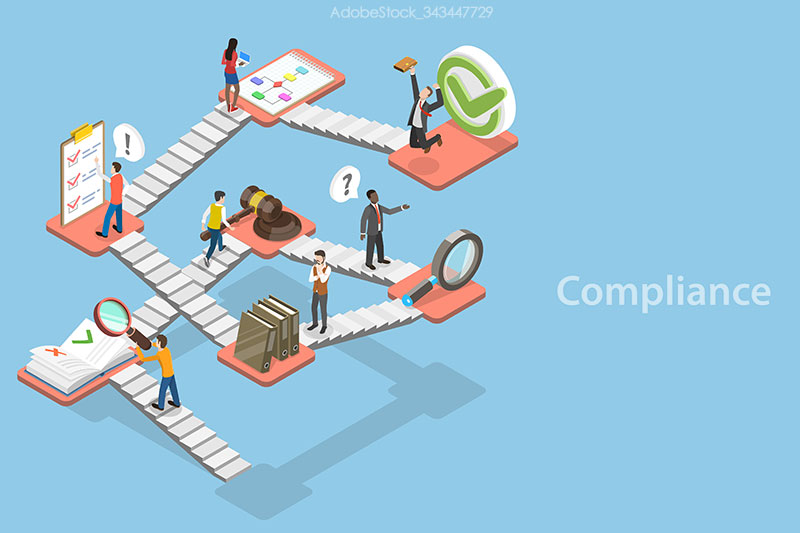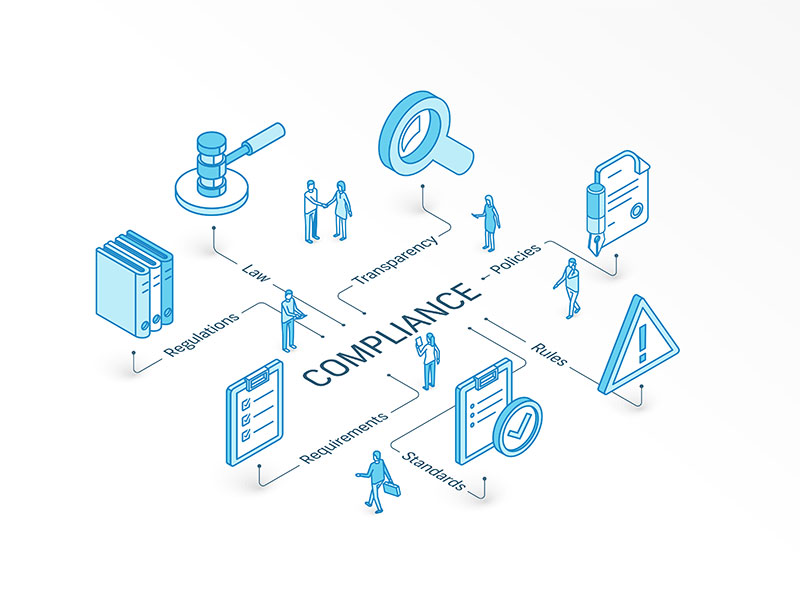Compliance Management System:
Secure your company
Every company has a set of rules and regulations designed to prevent problems and chart the company's course. These rules and regulations are often well thought out and help your company (as long as they are adhered to) to achieve corporate goals such as higher occupational safety and more sales.
Unfortunately, it happens again and again that the given rules are intentionally or unintentionally ignored. These rule violations can lead to major problems within your company. The solution: With a Compliant Management System you can ensure compliance with standards, rules and legal requirements.
Many modern companies now rely on compliance management systems. In this article, we would like to discuss various compliance topics. We will shed light on the term Compliant Management System and how good compliance helps your company.
We will look with you at the reasons for compliance and some examples of possible compliance measures. To conclude the article, we will show you how to build your own compliance system without much effort and thereby position your company securely for the future.
Drive the digital transformation in your company today!
What is compliance?
A company is confronted with a multitude of standards, legal requirements and rules that should be adhered to for a smooth workflow. Adherence to these rules, standards and legal requirements is referred to as compliance (German: Erhaltung, Einhaltung).
What does management mean?
In the context of Compliant Management, it is also worth taking another closer look at the common term.
Management is the control, steering and planning of tasks, processes and activities. Accordingly, if you create a schedule for yourself, you are already a manager.
What is Compliance Management?
The management of all measures that serve to ensure compliance with standards, laws and rules, as well as their monitoring and control in your company, are referred to as compliance management.
The higher the quality and professionalism of your compliance management, the easier it will be for you to comply.
Which compliance topics & compliance guidelines affect my company?
Basically, two types of compliance objectives can be distinguished:
- Legal compliance: Legal requirements are intended to make your company safer, less harmful to the environment and more socially responsible. Examples of legal requirements include environmental protection, compliance with working hours, and occupational health and safety. Your company must comply with these requirements, otherwise you may be subject to severe penalties.
- Voluntary rules & standards: In addition to laws and regulations, your compliance program can also include voluntary rules and standards. You impose these on yourself and the company to provide additional safety and even better working or environmental conditions. In many cases, it is the voluntary compliance requirements that give you decisive competitive advantages.
Adherence to both compliance targets is very important for your company's success. To ensure compliance, however, you need the right compliance organization for your measures.


What is compliance organization?
A good compliance organization describes the fact that you give sufficient thought to compliance with legal and voluntary requirements. Above all, the implementation of these requirements through suitable measures is crucial to the success of your compliance. Only in this way can you organize your workforce in a meaningful way and put your ideas into practice.
What are the reasons for compliance in your company?
There are many reasons for establishing corporate compliance. We have compiled some of the most important advantages of a well-established and professional compliance. You can use these advantages as a guide.
Nevertheless, there are some additional advantages that may arise depending on the company and its size. Here's how you can benefit even more from building a professional compliance.
- Fewer legal proceedings: Failure to comply with legal requirements is often punishable by severe penalties. If your company fails to comply with environmental protection, occupational safety, etc. requirements, you will often find yourself in legal proceedings. Through compliance, you can significantly reduce the number of violations, thereby protecting your wallet and your nerves.
- Competitive advantages: Voluntary compliance regulations and standards can position your company more distinctively against the competition. Higher product quality, more satisfied employees and improved environmental protection are just three examples of potential advantages over your competitors through compliance.
More satisfied customers: Often, compliance also serves to ensure product quality. Your customers will notice the difference when you use compliance to significantly improve the quality of your products and sell better products and services. - Motivated workforce: You can only achieve truly excellent compliance if you involve your workforce. Your employees know where the sources of error are hidden within processes and tasks.
With good compliance, you can discover these error devils and develop suitable countermeasures. By involving your employees, they feel valued and additionally increase effectiveness by complying with standards and guidelines.
How does compliance work in the company?
The implementation of a compliance strategy usually takes place in three steps:
- Establish the rules & standards: In order to comply with rules and standards, you must first define them. The first step in a compliance management system (i.e., a digitalized system in which compliance measures are implemented, managed and controlled) is therefore to define the rules.
Make yourself aware of the requirements your company has to meet and how you can design them in practice.
- Define & implement appropriate measures: We have just learned about some measures that you can put into practice to optimize your compliance. The selection of the appropriate measure depends on your individual set of rules and your financial and personnel requirements.
Control & adjust measures as well as their progress: Implementing the respective measure is not the end of the story. Regularly check whether benefits can be achieved through the measures or whether you need to optimize them.
Possible compliance measures in your company
There are a variety of different compliance measures that you can establish depending on your company's situation and size. In a small company, simple measures are often sufficient, while in a corporate group, a separate compliance department often needs to be established.
We have compiled a brief overview with various compliance measures that you can apply in your company:
- Use a compliance software: In many cases, the use of a software is very helpful, as it is responsible for compliance and informing your workforce. Such software is sufficient for most companies to cover the main compliance risks.
At OBCC, we have developed our own software solutions that you can use to build and improve compliance in your company. These include LMRA Card Companion and ProtoCon.
- Hire a compliance officer: The first step to building your own compliance department is to hire a staff member. Expert opinion can help you improve your company's compliance and introduce further measures together.
- Establish guidelines: So that your employees* know how to help improve compliance, you should create specific guidelines for individual professionals. This way, your workforce can follow these guidelines and independently ensure compliance with rules and standards.
- Monthly Reporting & Controls: Your company has a variety of data available to you. Based on this data, you can see whether your workforce has implemented the compliance requirements.
You can also sort the violations by employee and department to get a better overview. Often, discussions with the affected employees are enough to eliminate violations of the rules.
Move your company forward with a compliance system!
A compliance system (i.e. compliance management with a system or software) can be a decisive competitive advantage and simplify your compliance. With the right compliance system, your compliance will (almost) take care of itself.
Compliance Management System in companies Definition & Translation
We have already defined compliance management as the establishment of measures, as well as the management and control of your company with regard to compliance with standards, laws and rules.
A compliance management system is a software that facilitates the management of the individual measures that serve to comply with rules and regulations in your company. Special digital tools are usually used for this purpose.
The CMS (Compliance Management System) pursues the same goals as regular compliance, but offers a few nice extras that we'll take a closer look at in the next paragraph.
Compliance Management System elements for the success of your company
Not every CMS is of high quality and suitable for ensuring the success of your company. In this paragraph, we would like to show you how you can recognize a professional CMS and thereby separate the wheat from the chaff.
A high-quality compliance management system has the following elements or features that you can use as advantages for your company:
- An intuitive user interface: your employees and yourself have to work with the compliance management system on a daily basis. Accordingly, intuitive usability (i.e. user-friendliness) should be taken into account during development. Only if the app or software is enjoyable for you and your staff will it be used.
For the compliance management system to be successful, it should be used. Therefore, an investment in usability is always an investment in the success of your system.
- Additional functions: Your compliance management system should have all the functions that you would use without the software. Beyond that, however, it makes sense to include additional extras and tools that further simplify your work. Take advantage of the digital world and the multitude of functions that software offers within compliance (e.g., reporting in real time, convenient creation of PDF reports, etc.).
- Time savings: Time savings are closely related to the additional functions. Only if the software really saves you working time and nerves is it worth investing in a CMS.
A good compliance management system automates certain work reports and ensures that other compliance tasks (especially routine tasks such as documenting the sources of errors within a process) take less time.
- Fast information channels: In many cases, compliance management is slowed down by one factor in particular: extra work. Errors are noticed, but not reported because, for example, a whole A4 sheet of information has to be provided. With a high-quality CMS, you can use a direct communication channel and send error messages to the responsible employees.
In addition, the reporting process itself is simplified, so that many more errors can be reported and corrected in the future. You too can simplify the communication of compliance guidelines and requirements with good software.


Setting up a compliance management system in your company
Good compliance management can help your company use existing potential more efficiently and improve working conditions for your employees and external third parties.
However, in order to benefit from these advantages, your compliance management system must be professionally designed and tailored to your company.
At OBCC, we have gained a lot of experience over the past years with clients who wanted to set up a compliance system. As a result, we have some tips that we would like to share with you to make the implementation of your compliance management system a success:
- Use a digital compliance management system: digital features and extras have enabled our clients to significantly increase the efficiency of their companies and simplify the implementation of the compliance management system. Our digital tools fit perfectly into your workflows, ensuring a smooth transition.
In addition, you can check compliance with rules, standards and regulations more easily and inform your employees digitally about new developments.
- Involve your employees in the changeover at an early stage: Nothing is more difficult to overcome than resistance from your workforce when introducing a new solution. For this reason, it is very important that you inform your employees in good time about the establishment of a compliance management system and demonstrate the benefits.
Only if you can convince your employees of the sense of the change, the system will quickly establish itself and be used. This is the prerequisite for a transition that you and your staff will enjoy and accept.
- Allow sufficient time for the creation of the rules and regulations: As already mentioned, you must first think about the standards and specifications that you implement voluntarily or due to legal requirements. Voluntary standards are often already established by corporate culture. However, it is worthwhile to question these specifications.
In addition to these standards, you should also consider legal requirements. Although you do not have to create these yourself, you should take them into account when creating your regulatory framework.
The compliance system is of great importance, as you will keep your company on track by adhering to the rules and regulations. Make sure the course is the right one by having enough foresight and attention to detail when setting the rules!
- Review your compliance management system at regular intervals: Requirements, laws and voluntary rules can change. Your compliance system should not be set in stone, but should be flexible to adapt to current conditions. A regular review will help you stay abreast of any
Implementing the Compliance Management System is no magic trick
The implementation itself should not be a problem for you, provided you have chosen a high-quality compliance management system. In the best case, you will not have to modify any processes, but only adapt them slightly to the software.
At OBCC, we have helped many customers to set up a compliance management system in recent years. Our software can be easily integrated into your company and your processes. No matter if you decide for a ready-to-use software like ProtoCon or if you want to develop an individual software together with us: We accompany you on your way to a digital compliance management system.
At your request, we will also advise you on implementation and ensure that the software is integrated into your processes quickly and easily. This way, you can digitalize your business processes and control them better. Simply contact us!
Thanks to a modern Compliance Management System Example of digital success.
A compliance management system offers you many advantages:
- You save time
- You have more fun processing compliance cases thanks to a pleasant user interface
- You convince your customers and employees with modern solutions
Especially if you work with customer data or manufacture products for customers, a good compliance management system can be crucial for your success. In these areas, the prevention of errors is particularly important!
However, in order to benefit from all the advantages mentioned above, you should only rely on high-quality software. At OBCC, you can choose software modules that have been tried and tested in practice and combine them with each other.
Our software ProtoCon, for example, can be excellently complemented with our messenger RapidInfo. In practice, this allows you to quickly point out security gaps to employees, e.g. after a construction site documentation.
In addition, we can also create individual solutions for you, so that you can, for example, set up a comprehensive compliance management system that is tailored exactly to your needs and helps you avoid uncertainties.
We look forward to meeting you and working with you to develop the right software product for your compliance management system.
Your Walter Lorz from OBCC
